NCERT Solutions for Class 12 Micro Economics Chapter -7 Supply
NCERT TEXTBOOK QUESTIONS SOLVED
Question 1. Consider a market with two firms. The following table shows the supply schedules of two firms: the SS
1
column gives supply schedule of firm 1 and SS
2
column gives supply schedule of firm 2. Compute the market supply schedule. [3 Marks]
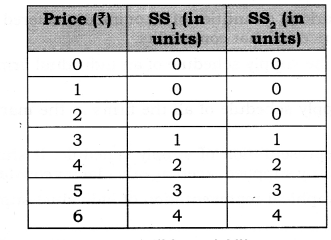
Answer:
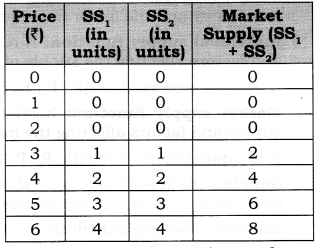
Question 2. Consider a market with two firms. In the following table, columns labelled as SS
1
and SS
2
give the supply schedules of firm 1 and firm 2 respectively. Compute the market supply schedule. [3 Marks]
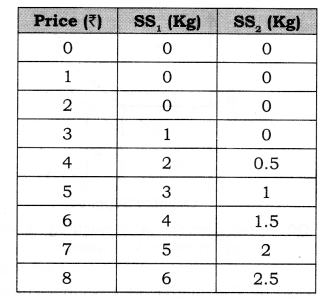
Answer:
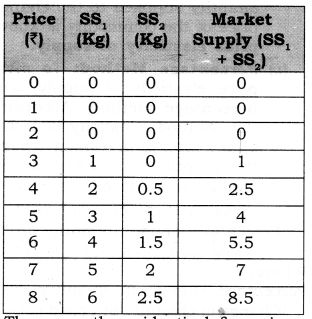
Question 3. There are three identical firms in a market. The following table shows the supply schedule of firm 1. Compute the market supply schedule.
[3 Marks]
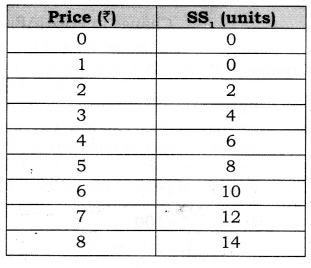
Answer:
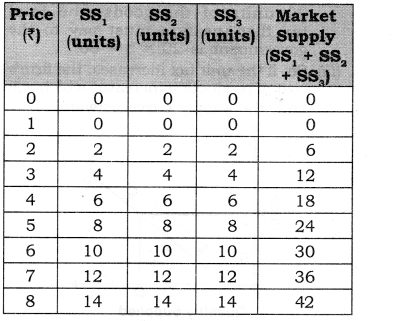
of the second firm (SS2) and the third firm (SS3) will be equal to the supply of first firm (SS,).
Question 4. How does technological progress affect the supply curve of a firm? [3 Marks]
Answer:
When there is technological progress in the firm, then cost of production will decrease, which leads to increase in the profit margin of the firm and thereby shifts the supply curve rightward as showm.
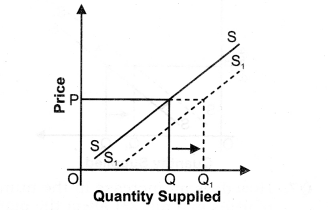
Question 5. How does the imposition of a unit tax affect the supply curve of a firm? [3 Marks]
Answer:
(i) A unit tax is a tax that the government imposes per unit sale of output.
(ii) For example, suppose that the unit tax imposed by the government is Rs 3.
Then, if the firm produces and sells 20 units of the goods, the total tax that the firm must pay to the government is 20 x 3 = 60.
(iii) So, if the unit tax increases, the firm’s cost of production increases which will shift the supply curve leftward.
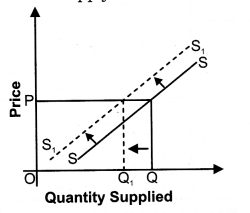
Question 6. How does an increase in price of an input affect the supply curve of a firm? [3 Marks]
Answer:
(i) This also influences the supply since price of inputs (rent, wages, interest, profit) constitutes the cost of production of a commodity.
(ii) An increase in the price of an input may lead to rise in cost of production, which will thereby decrease the production of a commodity shifting the supply curve to the left as shown.
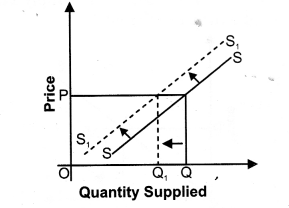
Question 7. How does an increase in the number of firms in a market affect the market supply curve?
[3 Marks]
Answer:
(i) When the number of firms in the industry increases, market supply also increases due to large number of producers producing that commodity.
(ii) So, due to increase in market supply, the supply curve shifts rightward as shown.
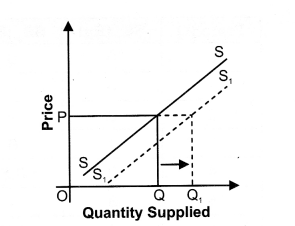
Question 8. What does the price elasticity of supply
mean? How do we measure it? [3-4 marks]
Answer:
(i) The degree of responsiveness of quantity supplied to the changes in price of the commodity is known as price elasticity of supply.
(ii) Percentage Method: To measure price elasticity of supply, we use percentage method. According to this method, elasticity is measured as the ratio of percentage change in the quantity supplied to percentage change in the price.Price elasticity of supply (ES) Percentage change in quantity supplied Percentage change in price
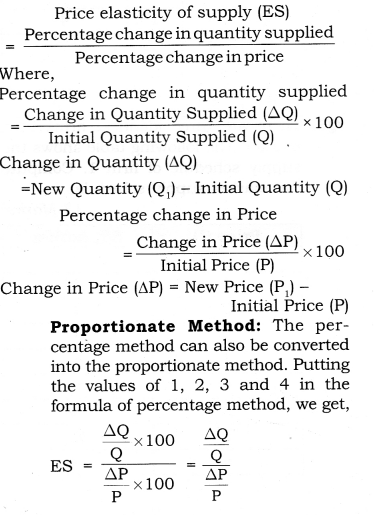
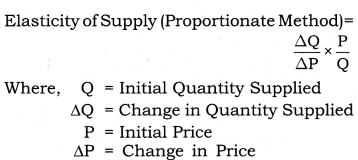
Question 9. What is the supply curve of a firm in the short run? [3 Marks]
Answer:
(i) In the short period, supply is relatively less elastic as firm can change the supply by changing the variable factors only, as fixed factors remain fixed during short period.
(ii) The supply curve during short period is inelastic, ie., percentage change in quantity supplied is less than percentage change in price as shown below:
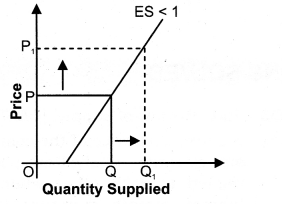
Question 10. What is the supply curve of a firm in the Long run? [3 Marks]
Answer:
(i) In the long period, supply is more elastic as all the factors can be changed and supply can be easily adjusted as per changes in price.
(ii) The supply curve during long period is elastic, i.e., percentage change in quantity supplied is greater than per¬centage change in price as shown below:
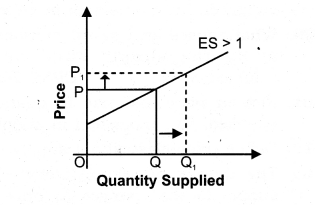
Question 11. At the market price of Rs. 10, a firm supplies 4 units of output. The market price increases to Rs. 30. The price elasticity of the firm’s supply is 1.25. What quantity will the firm supply at the new price? [3 Marks]
Answer:
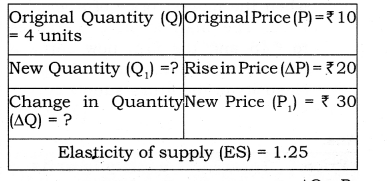
Question 12. The market price of a good changes from Rs. 5 to Rs. 20. As a result, the quantity supplied by a firm increases by 15 units. The price elasticity of the firm’s supply curve is 0.5. Find the initial and final output levels of the firm. [3 Marks]
Answer:
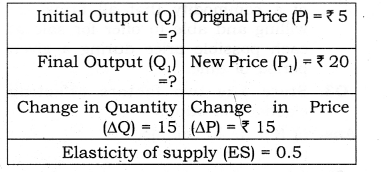
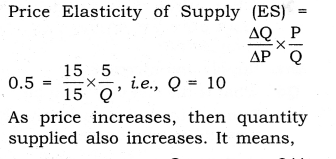
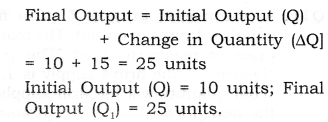
Question 13. A firm earns a revenue of Rs. 50 when the market price of a good is Rs. 10. The market price increases to Rs. 15 and the firm now earns a revenue of Rs. 150. What is the price elasticity of the firm’s supply curve?
Answer:
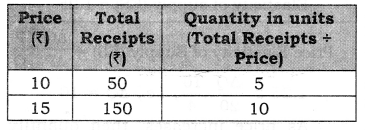
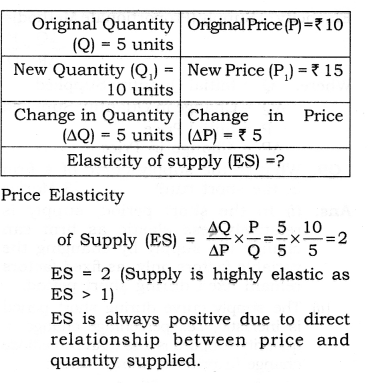
ES is always positive due to direct relationship between price and quantity supplied.
MORE QUESTIONS SOLVED
1. Very Short Answer Type Questions (1 Mark)
Question
1. Define supply. [CBSE, Foreign 2004]
Answer:
Supply refers to the quantity of a commodity that a firm is willing and able to offer for sale, at each possible price during a given period of time.
Question 2. Define market supply. [CBSE 2005]
Answer:
Market supply refers to the quantity of a commodity that all firms are willing and able to offer for sale at each possible price during a given period of time.
Question 3. State any two factors affecting elasticity of supply.
Answer:
(i) Nature of commodity;
(ii) Time period.
Question 4. What effect does an decrease in input price has on the supply of the commodity?
Answer:
Supply will increase.
Question 5. What is the shape of a supply curve?
Answer:
Supply curve is a positively shaped upward sloping curve.
Question 6. State the law of supply. [CBSE 2003]
Answer:
It states that price of the commodity and quantity supplied are positively related to each other when other factors remain constant (ceteris paribus).
Question 7. What causes a movement along the supply curve of a good? [CBSE 2004]
Answer:
Change (increase or decrease) in price causes a movement along the supply curve.
Question 8. What causes a downward movement along a supply curve? [CBSE 2004, 09]
Answer:
Fall in price and fall in quantity supplied, i.e., contraction in supply.
Question 9. What causes an upward movement along the supply curve of a commodity? [CBSE 2004]
Answer:
Rise in price and rise in quantity supplied, i.e., expansion in supply.
Question 10. Define price elasticity of supply.
Answer:
The degree of responsiveness of supply to the changes in price of the commodity is known as Price Elasticity of Supply.
Question 11. If the quantity supplied does not change at all as price changes, what will be the elasticity of supply?
Answer:
Perfectly inelastic supply (ES = 0).
Question 12. What is the price elasticity of supply of a commodity whose straight line supply curve passes through the origin forming an angle of 75°?
[CBSE Sample Paper 2010]
Answer:
Unitary elastic (ES = 1).
Question 13. When is the supply of a commodity called ‘elastic’? [CBSE 2006\
Answer:
The supply of a commodity is called ‘elastic’ when the percentage change in quantity supplied is more than percentage change in price, then ES > 1 and the result is known as more than unit elastic supply.
Question 14. Price elasticity of supply of a good is 0.8. Is the supply ‘elastic’ or ‘inelastic’, and why? [CBSE Outside, CBSE 2006]
Answer:
When PES = 0.8, PES is inelastic because percentage change in quantity supplied is less than percentage change in price.
Question 15. What is meant by perfectly elastic supply of a commodity? [CBSE 08C]
Answer:
When quantity supplied changes and price remains constant, then the supply of such commodity is said to be perfectly elastic.
Question 16. Price elasticity of supply of a good is 1.5. Is the supply ‘elastic’ or ‘inelastic’, and why?
Answer:
When PES = 1.5, PES is elastic because percentage change in quantity supplied is more than percentage change in price.
II. Multiple Choice Questions (1 Mark)
Question
1. A vertical supply curve parallel to Y-axis implies that the elasticity of supply is:
(a) Zero (b) Infinity
(c) Equal to one
(d) Greater than zero but less than infinity.
Answer:
(a)
Question 2. The supply of a good refers to:
(a) Actual production of the good.
(b) Total existing stock of the good. (c) Stock available for sale.
(d) Amount of the good offered for sale at a particular price per unit of time.
Answer:
(d)
Question 3. An increase in the supply of a good is caused by:
(a) Improvements in its technology.
(b) Fall in the prices of other goods. (c) Fall in the prices of factors of production.
(d) All of them.
Answer:
(d)
Question 4. Elasticity of supply refers to the degree of responsiveness of supply of a good to changes in its:
(a) Demand. (b) Price.
(c) Cost of production.
(d) State of technology.
Answer:
(b)
Question 5. A horizontal supply curve parallel to the quantity axis implies that the elasticity of supply is:
(a) Zero. (b) Infinite.
(c) Equal to one.
(d) Greater than zero but less than one.
Answer:
(b)
Question 6. Contraction of supply is the result of:
(a) Decrease in the number of producers. (b) Decrease in the price of the goods concern.
(c) Increase in the prices of other goods. (d) Decrease in the outlay of sellers.
Answer:
(b)
Question 7. The quantity supplied of a piece of goods or service is the amount that
(a) is actually bought during a given time period at a given price.
(b) producers wish that they could sell that at a higher price.
(c) producers plan to sell during a given time period at a given price.
(d) people are willing to buy during a given time period at a given price.
Answer:
(c)
Question 8. Supply is the
(a) limited resources that are available with the seller.
(b) cost of producing a good.
(c) entire relationship between the quantity supplied and the price of good.
(d) willingness to produce a good if the technology to produce it becomes available.
Answer:
(c)
Question 9. Elasticity of supply is measured by dividing the percentage change in quantity supplied of a good by .
(a) percentage change in income
(b) percentage change in quantity demanded of good
(c) percentage change in price
(d) percentage change in taste and preference
Answer:
(c)
Question 10. Elasticity of supply is zero means
(a) perfectly inelastic supply
(b) perfectly elastic supply
(c) imperfectly elastic supply
(d) none of them
Answer:
(a)
Question 11. Elasticity of supply is greater than one when . __
(a) Proportionate change in quantity supplied is more than the proportionate change in price.
(b) Proportionate change in price is greater than the proportionate change in quantity supplied.
(c) Change in price and quantity supplied are equal
(d) None of them
Answer:
(a)
Question 12. If the quantity supplied is exactly equal to the relative change in price then the elasticity of supply is .
(a) less than one (b) greater than one
(c) one (d) none of them
Answer:
(c)
Question 13. If the percentage change in supply is less than the percentage change in price, it is called .
(a) unit elasticity of supply
(b) less elastic supply
(c) more elastic supply
(d) inelastic supply
Answer:
(b)
Question 14. The supply curve shifts to the right because of .
(a) improved technology
(b) increased price of factors of production
(c) increased excise duty
(d) all of them
Answer:
(a)
Question 15. Supply is a concept.
(a) stock (b) flow and stock
(c) flow (d) none of them
Answer:
(c)
16. In a very short period market:
(a) The supply is fixed.
(b) The demand is fixed.
(c) Demand and supply are fixed.
(d) None of them.
Answer:
(a)
III. Short Answer Type Questions (3-4 Marks)
Question
1. Explain the concept of law of supply.
Or
State law of supply. [A1 2004]
Or
What is meant by the assumption, ‘other things remaining the same’ on which law of supply is based?[CBSE 2010]
Answer:
It is based on certain assumptions. If these assumptions fulfil in the economy, Law of supply states that positive relationship exists between price of the commodity and quantity supplied of that commodity.
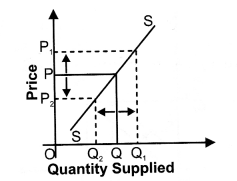
“Other things being constant (ceteris paribus), based on the price of the commodity” is called Law of Supply. It means due to rise in price of a commodity its quantity supplied also rises
and vice-versa.
The assumptions are as under:
(a) Price of other commodity remains constant.
(b) Technology of production should not change.
(c) Cost of production remains constant.
(d) Goal of the firm remains constant.
(e) Taxation policy of the government should not change.
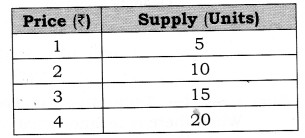
Question 2. Under what condition, a producer would like to supply more at a given level of price?
Or
What is increase in supply? Explain three causes of increase in supply.
Or [CBSE 2007, 11} State factors that can cause a rightward shift of supply curve. [AI 2002, 04; CBSE 04, 05C, 06]
Answer:
An increase in supply means that producers now supply more at a given price level.
The conditions or causes are:
(a) Fall in the prices of other goods.
(b) Fall in the prices of remuneration of factors of production.
(c) Improvement in Technology.
(d) Change in objective of producer (increase the supply at the same rate).
(e) Taxation policy of government falls.
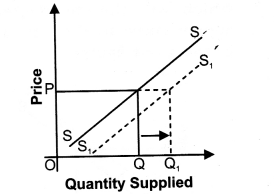
Question 3. Under what conditions, a producer would like to supply less at a given price?
Or
Explain only two causes of decrease in supply of a commodity.[CBSE 2010, 10C; AI11] Or
State factors for leftward shift of supply curve. [AI 2006]
Answer:
A decrease in supply means that producers now supply less at a given price level. The conditions are:
(a) Rise in the prices of remuneration of factors of production.
(b) Rise in the prices of other goods.
(c) When the technology becomes outdated.
(d) Change in the objective of producer (decrease supply at the same price).
(e) Taxation policy of government rises.
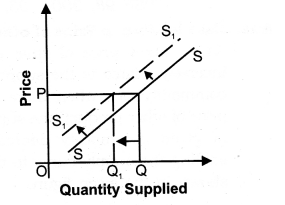
Question 4. Explain how changes in prices of inputs influence the supply of a product. [AI 2012, CBSE 2013 ]
Answer:
Case I— When price of input rises:
Due to rise in price of input the cost of production of a firm increases, which will thereby decrease the supply curve to the left as shown in the given figure.
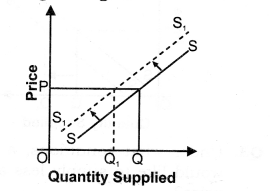
Case II— When price of input falls:
Due to fall in price of input, the cost of production of a firm decreases which will thereby increase the supply curve to the right as shown in the given figure.
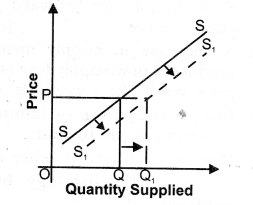
Question 5. Explain effect of ‘change in prices’ of other products on supply of a given product. [AI 2012,
CBSE 98, 2001, 03, 05, 13C]
Answer:
Case I— Rise in Price of other Goods: As we know price of other goods are inversely related to the supply of given commodity. So, when there is rise in price of other product, the supply curve of given commodity decreases and shifting the supply curve to the left as shown in the given figure.
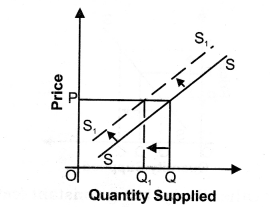
Case II— Fall in price of Other goods: As, against it, if there is fall in price of other product, the supply curve of a given commodity increases and shifting the supply curve to the right as shown below:
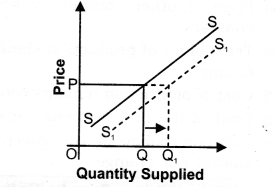
Question 6. Explain effect of technological changes on supply of a product. [AI 2001; CBSE 2005C]
Answer:
Case I— Technological Progress:
When there is technological progress in the firm, then cost of production will decrease, which leads to increase in the profit margin of the firm and thereby shifts the supply curve shifts rightward as shown below:
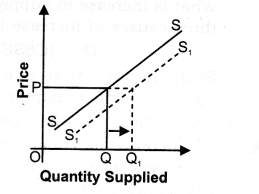
Case II— Outdated Technology:
Supply of those goods which are being produced with old and inferior technology causing increase in cost of production will decrease the total output and shift the supply curve to the left.
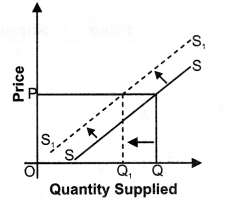
Question 7. What would be an effect on supply curve of the following:
(a) Decrease in tax on product.[CBSE 06C, 11; AI 08]
(b) Subsidy on production of goods.[CBSE 2011,13C]
(c) Rise in own price of a piece of goods. ‘ [CBSE 201 I]
Answer:
(a) Decrease in tax on product: Due to decreasein tax on product the cost of production of a firm decreases and supply of a given commodity increases and thereby shifts the supply curve rightward as shown in the given figure:
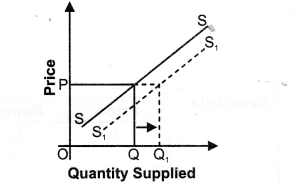
(b) Subsidy on production of goods:
If a government gives subsidy to a firm for production of goods, the cost of production of firm decreases for producing this goods, that will increase the supply and thereby shifting in the supply curve to the right as shown in the given figure:
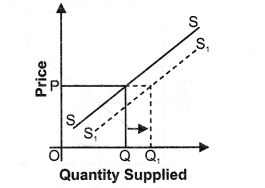
(c) Rise in own price of a good: Due to rise in own price of a good, the quantity supplied for a given commodity also rises because there is positive relationship between own price of a good and quantity supplied of a given commodity. So, due to rise in price of a commodity, there will be upward movement along the supply curve as given below:
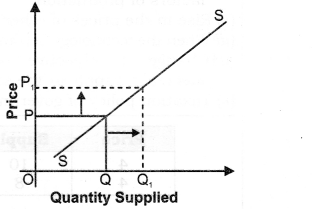
Question 8. Differentiate between increase in supply quantity supplied and expansion in supply increase in [CBSE 2000, 02, 09]
Answer:

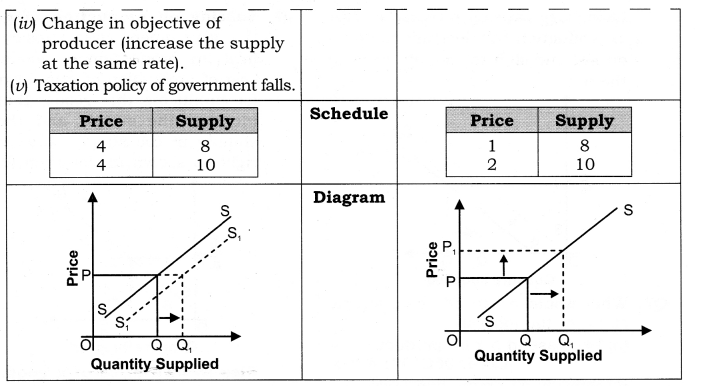
Question 9. Differentiate between decrease in supply and contraction in supply (decrease in quantity supplied). [Delhi 2000C]
Answer:
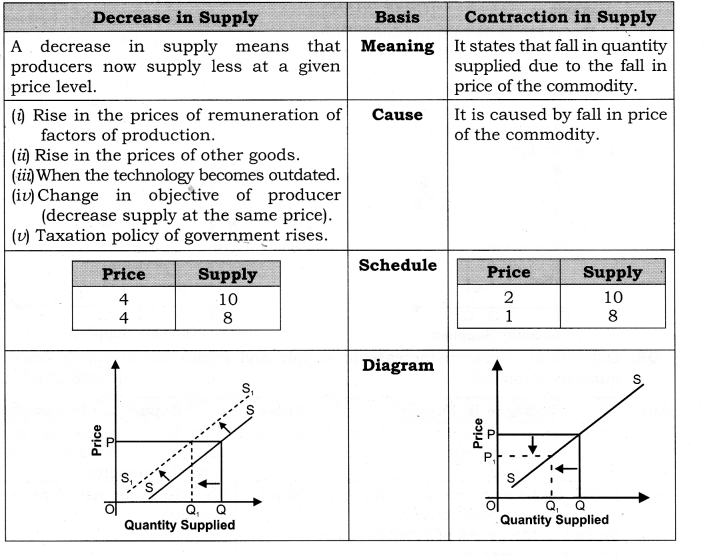
Numerical problems on Calculation of elasticity of supply (When both price and quantity are given)
Question 10. If price of a commodity falls from Rs. 50 per unit to Rs. 45 per unit, its supply falls from 1000 units to 800 units. Find out its elasticity of supply.
Answer:
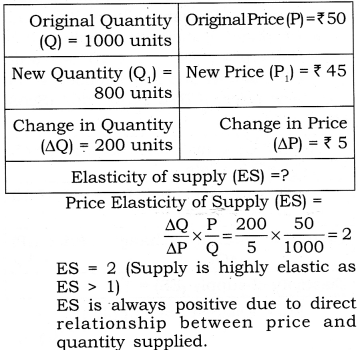
NCERT Solutions Accountancy Business Studies Micro Economics Commerce